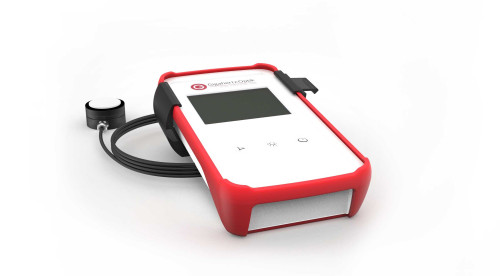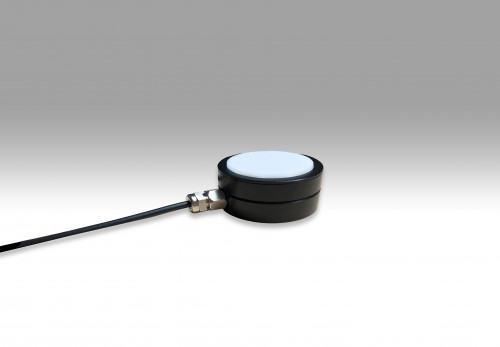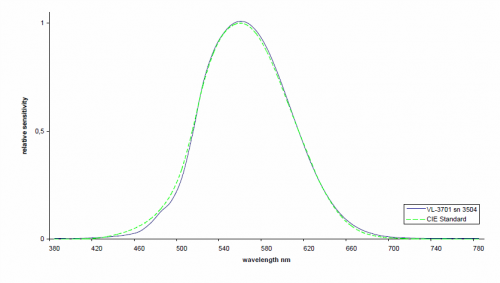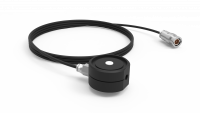该产品已停产。可能仍有剩余库存。请参阅下面 "类似产品 "下的替代产品或直接联系我们
VL-3707
Photometric detector for measuring very low illuminance in conjunction with the optional P-2110 Optometer.

Definition and examples of very low artificial and natural illuminance
Illuminance is the measure used to define the intensity of light falling on a surface as perceived by the human eye.
There are numerous examples of very low illuminance levels, including both artificial and natural light sources:
- Street lighting (10 lx)
- Emergency lighting of escape routes (at least 1 lx)
- Twilight (about 3 lx)
- Full moon night (0.05 - 0.36 lx)
- Starlight (0.00022 lx)
- Cloudy Night Sky (0.00013 lx)
In the above artificial lighting examples different standards and regulations, such as EN 1838, define minimum illuminance levels that must be maintained in occupied areas.
Measurement of very low illuminance
- Therefore, to measure the illuminance of emergency lighting for example, an illuminance meter must have a minimum resolution of 0.01 lx to provide sufficient signal-to-noise ratio to measure the required illuminance of 1 lx. For demanding technical and scientific applications, even this sensitivity is often insufficient:
- In goniometric measurements of lamps and luminaires, the luminous intensity outside of the desired beam profile is significantly lower than within it and ideally should be zero. The luminous intensity in goniometric applications is determined by the measured illuminance and the distance between the measuring head and the light source.
- First and second generation night vision devices provide 1000x and 20000x intensity gain respectively, enabling high-contrast images even in the darkest of ambient light conditions. To check night vision equipment in the laboratory and outdoors, very low illuminance in the area of the targeted objects must be reliably measured.
- For quality assurance testing of image intensifiers and night vision devices, their light amplification and imaging quality are checked. This requires uniform illumination with illuminance levels in the μlx range and luminance levels in the mcd / m² range for which reference levels must be determined. Integrating sphere based uniform light sources with very low light intensities are usually used as light sources for this application.
- Light pollution of the night sky resulting from the ever increasing use of artificial lighting is impacting both wildlife species and ecosystems as well as having possible detrimental effects on humans. Research requires the accurate measurement of low level illuminances.
VL-3707 detector head for very low illuminance
With the VL-3707, Gigahertz-Optik offers a highly sensitive light detector for measuring illuminance. Its high sensitivity is achieved by use of a latest technology photodiode with optimized quantum efficiency and an extremely high shunt resistance. In addition, high transmission photometric correction filters and diffuser windows support the high sensitivity. Furthermore, the high shunt resistance reduces the dark current, minimizing operating temperature effects.
P-2110 Optometer for very low Signals
The detection of the very small signal currents produced by the VL-3707 at low illuminance levels requires suitably matched low-level detection electronics. For this purpose Gigahertz-Optik offers their P-2110 Optometers. The transimpedance amplifier of the P-2110, in conjunction with its 16-bit ADC, provides a noise level in the range of femtoamperes (10-15 A), which provides a sufficient signal-to-noise ratio even for illuminances of 100 μlx. Equally important is the electronically adjustable offset adjustment at the signal input, which minimizes the effects of detector dark current signals. The offset adjustment function is also available via the RS232 interface. Due to the eight switchable amplification stages, the Optometer offers a very high dynamic range, which, in conjunction with the VL-3707, enables the measurement of illuminances beyond 80,000 lx. Together with the many measuring and evaluation modes, the P-2110 Optometers are the ideal detection and display device for measuring low illuminance in conjunction with the VL-3707 measuring head.
Calibration of illuminance responsivity
The Gigahertz Optics Laboratory offers factory calibrations of the highest level in terms of NMI traceability and calibration performance. This is guaranteed by our factory calibrations which are all subject to the same quality management as used by the DAkkS accredited testing laboratory of Gigahertz-Optik.

Illuminance detector head VL-3707

Typical spectral sensitivity of the photometric illuminance detector head VL-3707.

Luxmeter for very low illuminance levels consisting of optometer P-2110 with photometric detector head VL-3707.
类似产品/Similar Products
